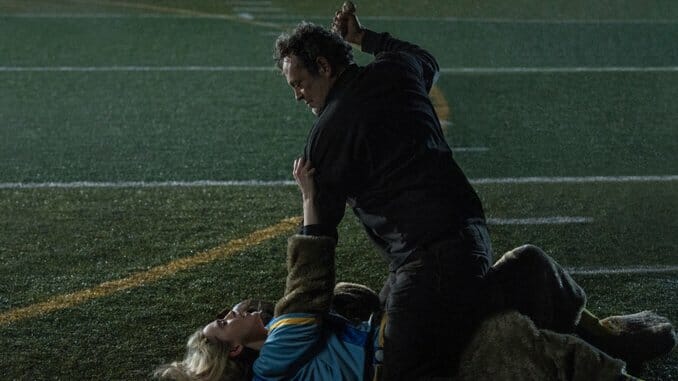
On its face, the prospect of resurrecting two franchise IPs which have been endlessly re-made decade after decade teeters on the banal and unimaginative. Yet director Christopher Landon’s Freaky effortlessly weaves together the conventions of Freaky Friday and Friday the 13th, eschewing the confines of “remake,” instead creating a unique genre hybrid that’s slick and endlessly entertaining—all the while maintaining a clever self-awareness which enlivens the film’s jump-scares and punchlines without descending into the horror-comedy pitfall of self-referential metaness.
Millie (Kathryn Newton) is a shy 17-year-old who has become even more reclusive since the death of her father. Her family life is imperfect: Her mother (Katie Finneran) struggles with alcoholism while her police officer sister, Char (Dana Drori), buries herself in work and largely neglects connecting with her younger sister. Her only respite are best friends Nyla (Celeste O’Connor) and Josh (Misha Osherovich), presented as fellow outcasts due to Nyla being Black and Josh’s openly gay identity. However, Freaky is conscious of horror tropes, employing clichés only to demonstrate how useless they are: Josh yells to Nyla early on in the film’s chilling plot, “You’re Black, I’m gay! We are so dead!”
Evidently, their small town has more sinister problems than simple bigotry: A serial killer known as the Blissfield Butcher (Vince Vaughn) has been culling the town’s teen population for years, notably committing a quadruple-homicide on Wednesday, November 11. Two days later, on Friday the 13th, Millie makes the classic mistake of electing to wait for her mom to pick her up on a lonely bench after a football game instead of taking a ride home with Nyla and Josh. Moments later, the killer is chasing Millie through bleachers and the vast football field, eventually pinning her down and stabbing her with an antique Aztecan dagger (that the Butcher stole from the house of his previous murderous rampage). Char arrives in time to scare the killer off, but at midnight, visions of the dagger arrest Millie’s dreams—and when she rouses, she doesn’t recognize herself.
What follows is a binary-bending comic exercise in sexual fluidity and gender expression which juxtaposes Vaughn’s hefty stature with Newton’s petite frame in order to prod at the horror genre’s previously held notion of who is perceived as weak, both in attitude and appearance. Vaughn and Newton give stellar performances, channeling the other’s mannerisms while poking fun at their own corporeal limitations and their immediate (dis)comfort within their new vessels. Newton’s Butcher quickly notes the advantages of his new appearance as a teenage girl, dually weaponizing Millie’s heretofore unrealized sex appeal and her simultaneously unassuming, innocent life as a high schooler in order to lure victims in and avoid suspicion. That the clearly unstable killer wakes up in the body of a young woman and immediately thinks, “I’m going to give this bitch an Ariana high-pony, some contour and a red lip,” perfectly exemplifies the overarching theme of gender performance and fluidity that is inextricable from the plot of Freaky.
Vaughn’s Millie is much more endearingly awkward, completely unaware of her physical power until provoked to defend herself from townspeople (including her own best friends) who only recognize her as the Butcher. As Millie painstakingly convinces Nyla and Josh of her plight through their careful interrogation, performing a school cheer and answering questions about her favorite movie (“I tell everyone it’s Eternal Sunshine, but really it’s Pitch Perfect 2” remains one of the most endearingly teen lines of the film), the gang discovers that Millie only has 24 hours to get her body back.
It turns out that Millie’s new body is both a help and a hindrance, easily able to overpower those who previously made her feel weak while also being clearly identifiable as the highly-publicized killer. She jokes about the newfound sensation of having a penis (and the downfall of possessing testicles), eventually confessing to the empowerment inherent in occupying this body. Through shedding a corporeal form that was routinely the source of scrutiny and ridicule among her peers, Millie is able to recognize the strength of her character—which is just as well at home in the body of a 200-pound man than in her previous vessel.
While the script is solidly crafted by Landon and co-writer Michael Kennedy, there are a few lines that masquerade so poorly as genuine teen-speak that it pulls one out of the story, necessitating that the viewer cackle with embarrassment, clearly in contrast with the comedic highs that Freaky often achieves throughout. However, one can posit that Landon and Kennedy are themselves trying to inhabit their figurative teen-girl vessels; the empowerment intrinsic in hijacking your sister’s Levi’s wedgie jeans and leather jacket, the mortifying ordeal of attempting to craft the best version of yourself when you have no idea who you are, let alone who you’re trying to be. It’s heartening to see that the horror genre—still undeniably male-dominated—persists in its commitment to pushing boundaries. Whether those boundaries demarcate what we are able to stomach in terms of violence or what we are able to unpack within our own internal concepts of gender and sexuality, Freaky joins these tenets in order to craft a horror story rife with unexpected, imaginative kills all while subverting societal expectations of who we should really be afraid of—and why.
Director: Christopher Landon
Writers: Christopher Landon, Michael Kennedy
Stars: Vince Vaughn, Kathryn Newton, Celeste O’Connor, Misha Osherovich, Uriah Shelton, Katie Finneran, Dana Drori, Alan Ruck
Release Date: November 13, 2020 (theatrical), December 4, 2020 (VOD)
Natalia Keogan is a Queens-based writer who covers film, music and culture, with particular interest in the horror genre and depictions of sexuality and gender. You can read her work in Narratively, Filmmaker Magazine and Paste, and find her on Twitter.